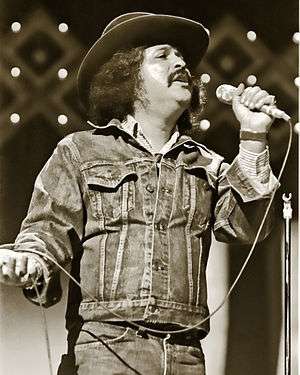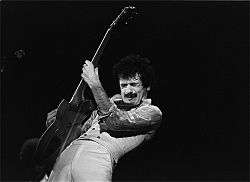Latin American music in the United States
Latin American music has long influenced American popular music, jazz, rhythm and blues, and even country music. This includes music from Spanish, Portuguese, and (sometimes) French-speaking countries and territories of Latin America.[1] Although Latin American music has also been referred to as "Latin music",[2] the American music industry defines "Latin music" as any release with lyrics mostly in Spanish regardless if the artist or music originates from Latin America or not.[3][4]
History
For an early example (1914), the bridge to "St. Louis Blues"--"Saint Louie woman, with her diamond rings"—has a habanera beat, prompting Jelly Roll Morton to comment, "You've got to have that Spanish tinge". Many an American band has added a conga player, maracas, or other Latin percussion for just that reason.

The Argentine tango was a worldwide success in the 1930s. Tango dancers and records could be found from Los Angeles to Beijing. In more recent times, artists such as Carmen Miranda, Desi Arnaz, Xavier Cugat, and Pérez Prado ("The Mambo King") were popular with audiences of all cultures. Judy Garland's first hit, as a member of the "Gumm Sisters", was "La Cucaracha."
It was common in dance halls in the 1930s and 1940s for a Latin orchestra, such as that of Vincent López, to alternate with a big band because dancers insisted on it. Latin American music was extremely popular with dancers, not only the samba, pasodoble, rhumba, and mambo, but even the conga (adapted for the ballroom). In the 1950s, Perez Prado made the mambo famous, and the Afro-Cuban jazz of Dizzy Gillespie opened many ears to the harmonic, melodic, and rhythmic possibilities of Latin American music and is still influential in salsa.
Latin American music imported from Cuba (chachachá, mambo, rhumba) and Mexico (ranchera and mariachi) had brief periods of popularity during the 1950s. The earliest popular Latin American music in the United States came with rhumba in the early 1930s, and was followed by calypso in the mid-1940s, mambo in the late 1940s and early 1950s, chachachá and charanga in the mid-1950s, bolero in the late 1950s and finally boogaloo in the mid-1960s, while Latin American music mixed with jazz during the same period, resulting in Latin jazz and the bossa nova fusion cool jazz.

The first Mexican-Texan pop star was Lydia Mendoza, who began recording in 1934. It was not until the 1940s, however, that musica norteña became popularized by female duets like Carmen y Laura and Las Hermanas Mendoza, who had a string of regional hits. The following decade saw the rise of Chelo Silva, known as the "Queen of the (Mexican) Bolero", who sang romantic pop songs.
The 1950s saw further innovation in the Mexican-Texan community, as electric guitars, drums and elements of rock and jazz were added to conjunto. Valeria Longoria was the first major performer of conjunto, known for introducing Colombian cumbia and Mexican ranchera to conjunto bands. Later, Tony de la Rosa modernized the conjunto big bands by adding electric guitars, amplified bajo sexton and a drum kit and slowing down the frenetic dance rhythms of the style. In the mid-1950s, bandleader Isidro Lopez used accordion in his band, thus beginning the evolution of Tejano music. The rock-influenced Little Joe was the first major star of this scene.

The "Spanish tinge" was also a common feature of rhythm and blues in the 1950s. The monster hit "Little Darling" was driven by the clave beat and Chuck Berry's "Havana Moon" was a great success. Ritchie Valens, born Ricardo Valenzuela, blew the roof off the hit parade with "La Bamba", originally a Mexican wedding song.
Likewise, Tex-Mex and Tejano style featured the conjunto sound, resulting in such important music as "Tequila" by The Champs, "96 Tears" by Question Mark and the Mysterians, Sam the Sham & the Pharaohs, Thee Midniters, and the many combinations led by Doug Sahm, including the Sir Douglas Quintet and the Texas Tornadoes. The Texas Tornadoes featured Freddy Fender, who brought Latin soul to country music. And the Tornadoes' Flaco Jiménez is a genuine conjunto hero, a third-generation accordionist whose grandfather learned the instrument from German settlers in Texas. Johnny Rodriguez is another Latin country star.
In the modern rock and roll era, Carlos Santana featured a full-blown Latin approach. Joe King Carrasco y las Coronas play punk rock Tex-Mex style. See also rock en español.
Herman Santiago wrote the lyrics to the iconic rock and roll song "Why Do Fools Fall in Love". Another song which became popular in the United States and which is heard during the Holiday/Christmas season is "Feliz Navidad" by José Feliciano.
1980s crossover acts
Starting in the mid-1980s, Billboard introduced the Top Latin Albums and Hot Latin Tracks charts for Latin music albums and singles.
Gloria Estefan is the most successful crossover performer in Latin music to date. She began crossing over to English music in 1984. Estefan at the time was with the Miami Sound Machine. Their more successful follow-up album, Primitive Love, was released in 1985, launching three Top 10 hits on the Billboard Hot 100: "Conga" (U.S. #10), "Words Get in the Way" (U.S. #5), and "Bad Boy" (U.S. #8) became follow–up hits in the U.S. and around the world. "Words Get in the Way" reached No. 1 on the US Hot Adult Contemporary Tracks chart, establishing that the group could perform pop ballads as successfully as dance tunes. The song "Hot Summer Nights" was also released that year and was part of the blockbuster movie Top Gun. Since then Estefan has bridged between both the English and Latin world for the mid to late 1980s, 1990s and 2000s.
1990s Latin Explosion

In the mid 1990s, Selena was gaining prominence within the Hispanic music world. Primarily marketed as a Tejano music artist, Selena's success was met with rhythmic Cumbia recordings. After bypassing several barriers within the Tejano industry, she quickly superseded other Latin artist acts and earned the title "Queen of Tejano Music". After being presented with a Grammy for Selena Live!, Selena became the first Latin artist to release four number–one singles, in 1994. With a meteoric rise in popularity, Selena was presented with the opportunity to record an English-crossover album.
Unfortunately, months before the release of her English album, Selena was murdered by her fan club president, on 31 March 1995, in Corpus Christi, Texas. Selena's incomplete album, titled Dreaming of You, was released in July 1995, topping the Billboard 200. Selena's songs "Dreaming of You" and "I Could Fall In Love" quickly became mainstream hits, and the album became among the "Top ten best-selling debuts of all time" along with being among the "best-selling debuts for a female artist". Selena became the first Latin artist, male or female, to have ever debuted with a No. 1 album, partially in Spanish.
Despite, and perhaps fueled by, Selena's death and crossover success, the "Latin explosion" continued in the late 1990s. At that time, a handful of rising stars who shared a Latin heritage were touted as proof that sounds from Latin countries were infiltrating the pop mainstream. These included Ricky Martin, Thalía, Marc Anthony, Enrique Iglesias and Jennifer Lopez, who rendered a Golden Globe performance as Selena on film. Like Estefan and Selena, many of these artists, including some who recorded in English after gaining fame singing in Spanish, had been influenced at least as much by American music and culture.
In 1994 Frank Sinatra personally invited Luis Miguel to participate on a duet in the album Duets II. Luis Miguel has been dubbed several times by the press and the media as the "Latin Frank Sinatra".[5] "Come Fly with Me" was the song of the duet with Luis Miguel.
Ricky Martin gained success with "La Copa de la Vida", which Martin made a major hit in an English version when he was chosen to sing the anthem of the 1998 FIFA World Cup. "The Cup of Life"/"La Copa de la Vida" reached number one on the charts in 60 countries and here in the states the English version went No. 45 on the Hot 100 charts. The song went Platinum in France, Sweden and in Australia, where it ultimately became the number one single of the year. The song was awarded "Pop Song of the Year" at the 1999 Lo Nuestro Awards.
Martin at the Grammy Awards was booked to sing on the show's live TV broadcast. The now-legendary performance of "The Cup of Life" stopped the show, earning Martin an unexpected standing ovation and introducing the star to the mainstream American audience. Martin capped off the evening by winning the award for Best Latin Pop Performance. Vuelve became Martin's first Top 40 album on Billboard Top 200 Albums chart in the U.S., where it was certified Platinum by the RIAA. The album notably went to No. 1 in Norway for three weeks, going on to sell eight million copies worldwide.
Martin prepared his first English album in 1999, as the first and most prominent single was "Livin' la Vida Loca", which reached number one in many countries around the world, including the United States, the United Kingdom, Argentina, Australia, Brazil, France, Greece, India, Israel, Italy, Japan, Guatemala, Mexico, Russia, Turkey and South Africa. He followed up with the hit "She's All I Ever Had", which peaked at No. 2 on The Billboard Hot 100. This album became one of the top-selling albums of 1999, and was certified seven times platinum, selling over 22 million copies worldwide to date.

Also in 1999, attempting to emulate the crossover success of Gloria Estefan, Selena and Ricky Martin in the anglophone market, Marc Anthony released an English-language Latin Pop self-titled album with the US Top 5 hit single "I Need to Know", and the Spanish version "Dímelo". Other hits include "When I Dream At Night" and "My Baby You". His song "You Sang To Me" was featured in Runaway Bride. The successful dance version was re-mixed by Dutch producer Rene Van Verseveld. The foray was considered a mixed success, partly because it alienated his traditional salsa fans, though "Da La Vuelta" (not a Spanish version of any of the songs) was a salsa song and was a hit. Another note is that the song "That's Okay" has more of a salsa tune than pop.

Enrique Iglesias had begun a successful crossover career into the English language music market. Thanks to other successful crossover acts, Latino artists and music had a great surge in popularity in mainstream music. Iglesias' contribution to the soundtrack of Will Smith's movie Wild Wild West, "Bailamos", became a number–one hit in the US. After the success of "Bailamos", several mainstream record labels were eager to sign Enrique. Signing a multi-album deal after weeks of negotiations with Interscope, Iglesias recorded and released his first full CD in English, Enrique. The pop album, with some Latin influences, took two months to complete and contained a duet with Whitney Houston called "Could I Have This Kiss Forever" and a cover of the Bruce Springsteen song "Sad Eyes". The album's third single, "Be With You", became his second number one.
Jennifer Lopez's debut album On the 6, a reference to the 6 subway line she used to take growing up in Castle Hill, was released on 1 June 1999, and reached the top ten of the Billboard 200. The album featured the Billboard Hot 100 number-one lead single, "If You Had My Love", as well as the top ten hit "Waiting for Tonight", and even the Spanish version of the song "Una Noche Mas" became a hit as well. The album also featured a Spanish language, Latin-flavored duet "No Me Ames" with Marc Anthony, who later would become her husband. Though "No Me Ames" never had a commercial release, it reached number one on the U.S. Hot Latin Tracks.
By the mid-nineties sales of Spanish language albums in the US by such acts as Luis Miguel, Enrique Iglesias and Ricky Martin had increased to compete with English language acts. To reflect the growing interest in Latin acts the American Music Awards instituted a category for Latin recording artists.
Martin was seen as the forerunner of a trend in pop music of using Latin tropes which the press dubbed a "Latin Pop explosion" or "Latin Invasion".
2000s Latin Invasion
.jpg)
After the 1990s, there were very few crossover acts that became successful in the 2000s. The only ones who proved successful were Shakira, Thalía, Paulina Rubio, Jennifer Lopez and Christina Aguilera, although the latter started at first in English and then turned to Spanish. Both Ricky Martin and Enrique Iglesias retained their roles as one of the most successful crossover artists this decade.
Colombian singer Shakira, who had been successful in the Latin world in the late 1990s, began working on an English crossover album in 2001. Thanks to other successful crossover acts in the 1990s, the crossover of Spanish artists to the English market had a great surge of popularity in mainstream music and it was the next logical step to Shakira and her label for her career, and Shakira worked for over a year on new material for the album. "Whenever, Wherever" ("Suerte" in Spanish countries) was released as the first and lead single from Shakira's first English album and third studio album throughout the period of August 2001 and February 2002. The song took heavy influence from Andean music, including the charango and panpipes in its instrumentation. The track was produced by Shakira, and it was an international success by reaching number one in most countries. It was also her first success in the U.S., reaching number six on the Hot 100.
Shakira's third studio album and first English language album, Laundry Service (Servicio De Lavanderia, in Latin America and Spain) was released on 13 November 2001. The album debuted at number three on the U.S. Billboard 200 chart, selling over 200,000 records in its first week. Laundry Service was later certified triple platinum by the RIAA in June 2004 as well and thus helped to establish Shakira's musical presence in the mainstream North American market. Seven songs from the album became international singles and hit mainstream as well: "Whenever, Wherever" / "Suerte", "Underneath Your Clothes", "Objection (Tango)" / "Te Aviso, Te Anuncio (Tango)", "The One", "Te Dejo Madrid", "Que Me Quedes Tú" and "Poem to a Horse", with four of the singles becoming largely successful.
Because the album was created for the English language market, the rock and Spanish dance-influenced album gained mild critical success, while some critics claimed that her English skills were too weak for her to write songs for it. Rolling Stone stated "she sounds downright silly" and "Shakira's magic is lost in translation." Shakira also was criticized by her Latin fans for seemingly abandoning her folk and rock roots in favor of contemporary American pop music. Despite this fact, the album became the best-selling album of 2002, selling 12 million copies worldwide and becoming the most successful album of her career to date.

After that success, Shakira's second English studio album, Oral Fixation Vol. 2, was released on 29 November 2005. The album debuted at number five on the Billboard 200, selling 128,000 copies in its first week. The album has gone on to sell 1.8 million records in the U.S., earning a Platinum certification from the RIAA. Oddly enough, the album didn't fare as well as its Spanish counterpart in the U.S., selling a few hundred thousand fewer records overall. Oral Fixation Vol. 2 has also gone on to sell over 8 million copies worldwide. The album, went on to spawn two more singles. "Hips Don't Lie", featuring Wyclef Jean, was released as the album's second single in February 2006. The song went on to become the highest–selling single of the 21st century and became Shakira's first number-one single on the Billboard Hot 100, in addition to reaching number one in over 50 countries. Shakira and Wyclef Jean also recorded a Bamboo version of the song to serve as the official theme of the 2006 FIFA World Cup.
In early 2007, Shakira worked with American R&B singer Beyoncé for the track "Beautiful Liar", which was released as the second single from the deluxe edition of Knowles' B'Day. In April 2007, the single jumped ninety-one positions, from ninety-four to three, on the Billboard Hot 100 chart, setting the record for the largest upward movement in the history of the chart at the time.
After that success, She Wolf was released in October 2009 internationally and then on 23 November 2009 in the U.S. The album received mainly positive reviews from critics, but only managed to sell 89,000 copies in its first week in the U.S., earning the number–15 spot on the Billboard 200. It has gone on to sell only 300,000 records in the U.S., becoming her least successful album there. However, the album has been moderately successful worldwide, having been certified Gold in Russia, Ireland, Switzerland, Poland, France, Argentina, Greece, and Hungary, Platinum in Spain, the United Kingdom, and the Middle East, 2x Platinum in Colombia and Mexico, and 3x Platinum in Taiwan. To date the album has sold 3 million copies worldwide, becoming Shakira's least successful studio album to date in terms of sales. The lead single, "She Wolf" and "Loba" were successful worldwide, reaching number one in Latin America, number two in Germany, Ireland, Italy, Estonia and Spain, number three in Switzerland and Austria, number four in the UK, France and Greece, number five in Canada and Belgium, number six in Finland, number nine in Japan, and number 11 in the U.S.
Christina Aguilera had been very successful in English, as in 2000, Aguilera began recording her first Spanish-language album with producer Rudy Pérez in Miami. Later in 2000, Aguilera first emphasized her Latin heritage by releasing her first Spanish album, Mi Reflejo, on 12 September 2000. This album contained Spanish versions of songs from her English debut as well as new Spanish tracks. However, some criticized Aguilera for trying to cash in on the Latin American music boom at the time. According to Pérez, Aguilera was only semi-fluent, while recording. She understood the language, because she has grown up with her father, who is a native of Ecuador. He added "Her Latin roots are undeniable.". The album peaked at number 27 on the Billboard 200 and went number one on the Billboard Latin Charts for a record 20 weeks. In 2001, it won Aguilera a Latin Grammy Award for Best Female Pop Vocal Album. The album went Gold in the U.S. She also won the World Music Award as the best selling Latin artist that year.

Jennifer Lopez officially released her first full Spanish-language album, Como Ama una Mujer, in March 2007. Her husband, singer Marc Anthony, produced the album with Estefano, except for "Qué Hiciste", which Anthony co-produced with Julio Reyes. The album peaked at number ten on the Billboard 200, number one on the U.S. Top Latin Albums for four straight weeks, and on the U.S. Latin Pop Albums for seven straight weeks. The album did well in Europe, peaking at number three on the albums chart, mainly due to the big success in countries such as Switzerland, Italy, Spain, France, Belgium, Greece, Germany, Austria, and Portugal.
On 24 July 2007 Billboard magazine reported that Lopez and husband Marc Anthony would "co-headline" a worldwide tour called "Juntos en Concierto" starting in New Jersey on 29 September. Tickets went on sale 10 August. The tour was a mix of her current music, older tunes and Spanish music. In a later press release, Lopez announced a detailed itinerary. The tour launched 28 September 2007 at the Mark G. Etess Arena and ended on 7 November 2007 at the American Airlines Arena in Miami, Florida. The lead single, "Qué Hiciste," was officially released to radio stations in January 2007. Since then, it has peaked at 86 on the U.S. Billboard Hot 100 and number one on the Hot Latin Songs and the Hot Dance Club Play. It also went top ten on the European chart. The video for the song was the first Spanish-language video to peak at number one on MTV's Total Request Live daily countdown.
Lopez won an American Music Award as the Favorite Latin Artist in 2007. With Como Ama Una Mujer, Jennifer Lopez is one of the few performers to debut in the top 10 of the Billboard 200 with a Spanish album.
This century also saw the crossover of some of Mexican recording artist like Paulina Rubio and Thalía into the English music industry, with bilingual albums, compilation album, that included hit songs in English and Spanish language, and the firsts solo English-language albums by this Mexican Pop artist. The best recording crossover artist has been Paulina Rubio with her first English-language album being Border Girl released on June 18, 2002. The album's lead single, "Don't Say Goodbye" would become her most successful song in English until her second bilingual album Brave!, two of its three singles "Me Gustas Tanto" (English: I Like You So Much) and "Boys Will Be Boys" became hits for Rubio with Boys will be Boys being Rubios most successful English song to date. The Other singles released from the Border Girl album were "Casanova", and "I'll Be Right Here (Sexual Lover)." Each of the main single releases, as well as other English songs on the album, have Spanish-language counterparts that became big hits on Billboard's Hot Latin Songs chart and vice versa for songs like Casonova which has an English-language counterpart of the same name. The Spanish-language counterpart for the song I'll Be Right Here (Sexual Lover) is "Y Yo sigo Aqui" (English: "And I'm Still Right Here") the Spanish version of the song by Mexican recording artist Paulina Rubio, taken from her fifth studio album Paulina.
In addition to collaborations with English recording artist like Paulina's song "Nada Puede Cambiarme" (English: Nothing Can Change Me) the music video, like the song itself, wouldn't have been complete without presence of the legendary former Guns N' Roses' guitarist, Slash. Thalia has collaborated with legendary American singer of traditional pop standards Tony Bennett in a duet for the song "The Way You Look Tonight". Viva Duets is the studio album by Tony Bennett, released in October 2012. Thalia's first English-language album, shares a title with Thalía's 1990 and 2002 Spanish-language albums. "I Want You" was the album's most popular song, peaking at number 22 on the Billboard Hot 100 and number seven in the Mainstream chart. It is her only song to date that has charted within the Billboard Hot 100. In Greece, the song peaked number twenty-six in Top 50 singles sales. The Spanish version of the song, "Me Pones Sexy" was released for the Spanish-language audience and also perform quite well on the Latin Charts, peaking within the top ten of the Hot Latin Tracks at number nine. The album's music incorporated Latin pop styles with rock, R&B, dance, and mariachi elements. Vicente Fernandez Mexicos singer of traditional pop ranchera standards and cultural icon also collaborated with singer Tony Bennett in a duet for Viva Duets for the song "Return To Me" (Regresa a Mí).
By the mid-2000s urban Latin American music increased in popularity with the advent of reggaetón. Songs such as "Gasolina" by Daddy Yankee and Shakira's "La Tortura" were top 40 hits.
Shakira collaborated with the South African group Freshlyground to create the official song of the 2010 FIFA World Cup in South Africa, "Waka Waka (This Time for Africa)", which is based on a traditional Cameroonian soldiers' Fang song named "Zangalewa" by the group Zangalewa or Golden Sounds. The song was made popular in her native Colombia in 1987 through west African DJs in Colombia. The single later reached the top 20 in Europe, South America and Africa and the top 40 in the U.S., and was performed by Shakira at the World Cup kick-off and closing. The Spanish version was successful as well.
Shakira's Sale el Sol was released as Shakira's seventh studio album on 19 October 2010. It will have both English and Spanish songs. Shakira and Enrique Iglesias have retained their roles as some of the most successful crossover artists this decade.
On May 2013 Christina Aguilera appeared on Mexican singer Alejandro Fernández's cover of "Hoy Tengo Ganas de Ti" from his album Confidencias.[6]
Contemporary Latin American Music

Today Latin American music has become a term for music performed by Latinos regardless of whether it has a Latin element or not. Acts such as Shakira, Jennifer Lopez, Enrique Iglesias and Pitbull are prominent on the pop charts. Iglesias who holds the record for most #1s on Billboard's Hot Latin Tracks released a bilingual album, inspired by urban acts he releases two completely different songs to Latin and pop formats at the same time. Mainstream artists and producers tend to feature more on songs from Latin artists and it's also become more likely that English language songs crossover to Spanish radio and vice versa.
Viva Duets is a studio album by Tony Bennett, released in October 2012.[7][8] The album is sung in English, Spanish and Portuguese; and features Latin American singers. Album's adaptations were written by Andres Castro, Edgar Barrera, Miguel Bose, Ricardo Arjona, Kany Garcia, Thalia, Franco De Vita, Dani Martin, and Mario Molina Montez.
The 2014 FIFA World Cup opening ceremony had performers that were dressed as several types of trees and flowers.[9] The entire ensemble performed three separate acts leading up to the finale where the ball opened up to reveal Brazilian singer Claudia Leitte, who sang alone for a few minutes before being joined by Jennifer Lopez and Pitbull, with whom she performed the tournament's official song "We Are One (Ole Ola)", which was co-written and recorded by the three artists.
Awards
The most prestigious Latin American music awards are the Latin Grammy Awards, launched in 2000. Billboard magazine also honors these artists, with the Billboard Latin Music Awards. The latter's nominees and winners are a result of performance on Billboard's sales and radio charts, while the Latin Grammy Awards nominees and winners are selected by the Latin Academy of Recording Arts & Sciences (LARAS).
See also
References
- ↑ Edmondson, Jacqueline (2013). Music in American Life: An Encyclopedia of the Songs, Styles, Stars, and Stories That Shaped Our Culture. ABC-CLIO. p. 639. ISBN 9780313393488.
- ↑ Torres, George (2013). Encyclopedia of Latin American Popular Music. ABC-CLIO. p. xvii. ISBN 9780313087943.
- ↑ Edwards, Bob (September 13, 2000). "Profile: Latin Grammys at the Staples Center in Los Angeles". NPR. Retrieved August 7, 2015. (subscription required (help)).
- ↑ Barkley, Elizabeth F. (2007). Crossroads : the multicultural roots of America's popular music (2. ed.). Upper Saddle River, NJ: Pearson Prentice Hall. p. 232. ISBN 9780131930735.
The U.S. record industry defines Latin music as simply any release with lvrics that are mostly in Spanish.
- ↑ "Buzz Briefs: Luis Miguel, Bon Jovi". CBS News. July 8, 2008.
- ↑ "Hoy Tengo Ganas De Ti [feat. Christina Aguilera]: Alejandro Fernández". Amazon.es (Spain). May 14, 2013. Retrieved October 11, 2013.
- ↑ "Viva Duets". Allmusic. Rovi Corporation. Retrieved October 24, 2012.
- ↑ Rothman, Lily (October 23, 2012). "Viva Tony Bennett: The Singer on His New Duets Album, Taking Lady Gaga's Call and His Dream Collaborator". Time. Retrieved October 23, 2012.
- ↑ "World Cup 2014 opening ceremony – as it happened". Guardian. 12 June 2014. Retrieved 13 June 2014.
Further reading
- Doeden, Matt (2013). American Latin Music: Rumba Rhythms, Bossa Nova, and the Salsa Sound. Twenty-First Century Books. ISBN 0761345051.



